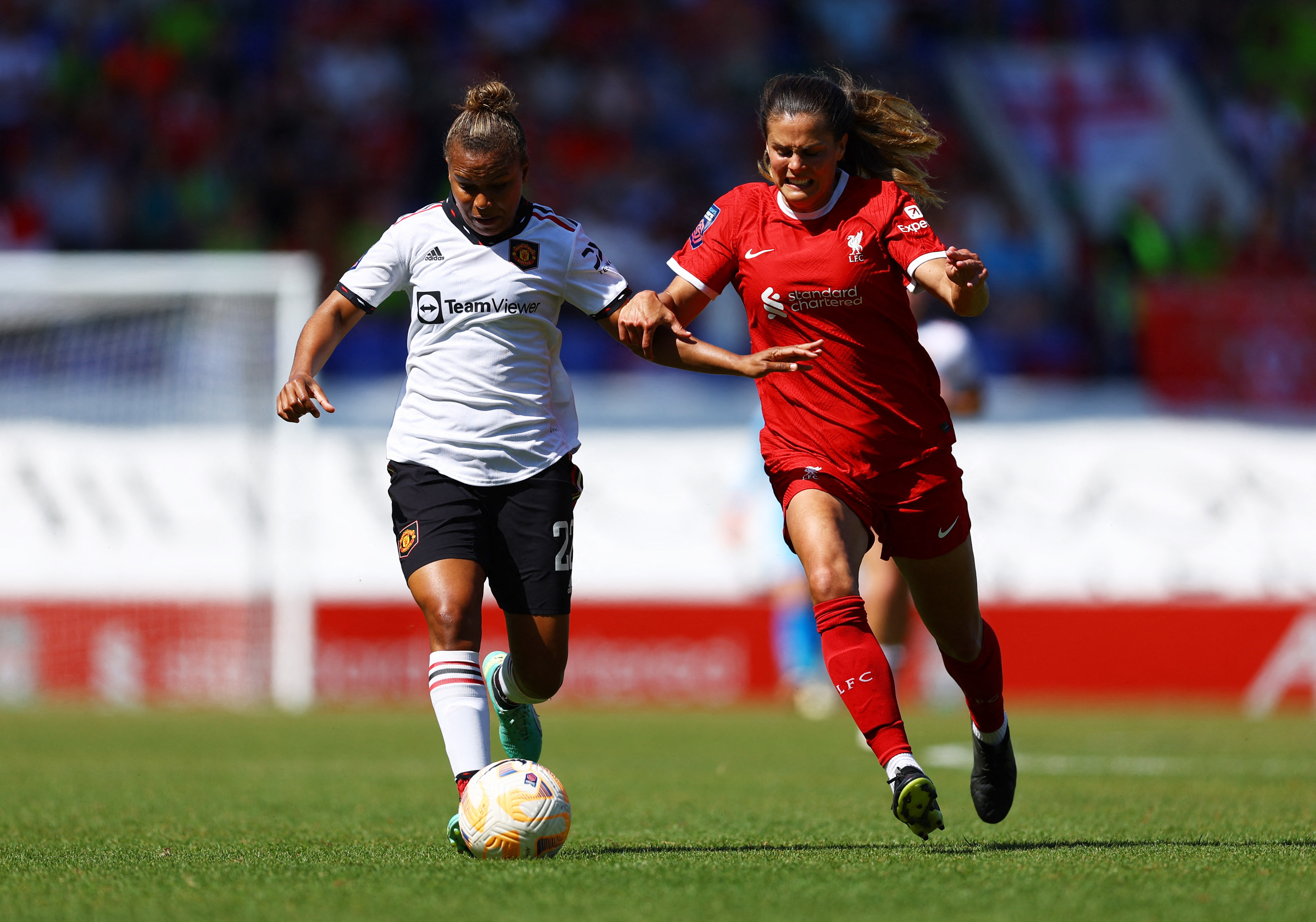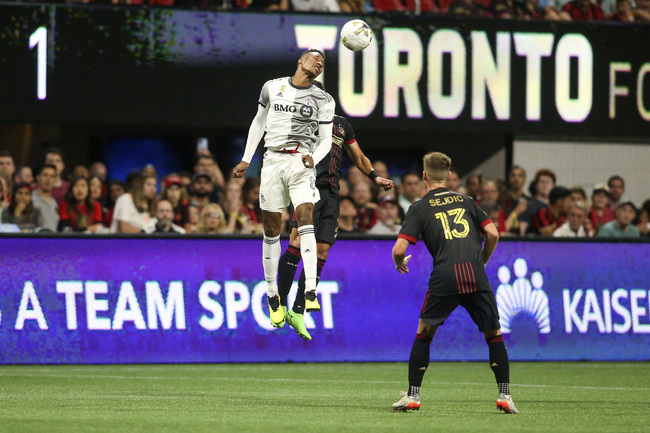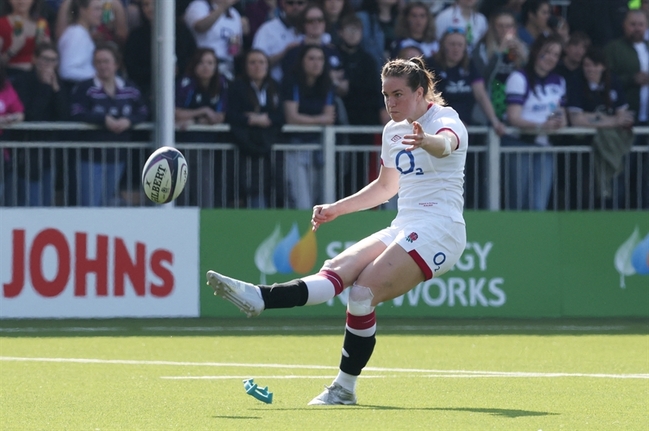You are viewing 1 of your 1 free articles
Adductor rehab: keep on the ball with a criteria-based plan!
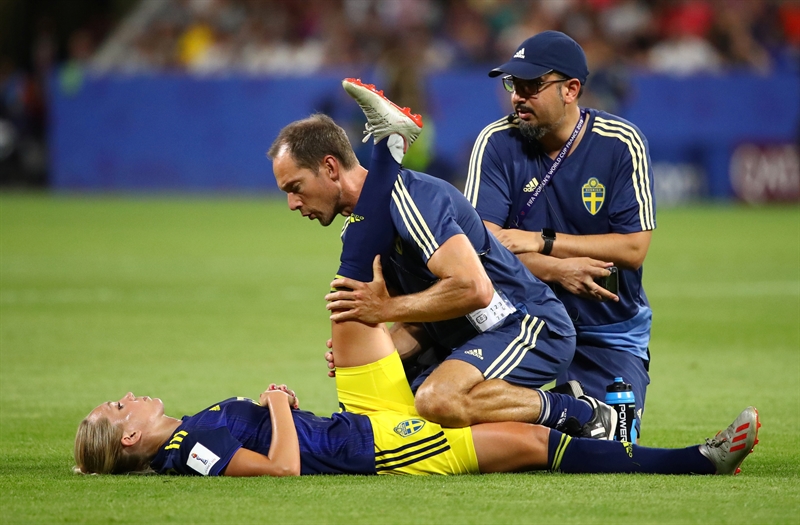
Athletes forced into isolation and withdrawn from contact exposure due to COVID-19 face an uphill challenge to return to professional levels of play and competition. With soccer as one of the first professional leagues to resume, players may be more susceptible to an acute adductor injury.
Adductor injury incidence
Acute adductor injuries are among the most common injuries in elite soccer due to the constant, rapid reactions required to keep up with unpredictable changes in the direction of play. These injuries tend to happen on the athlete’s dominant leg.Over half of acute adductor injuries occur due to closed-chain mechanisms like changes in direction (35%) and reaching (24%), with the remaining from open-chain movements including kicking (29%) and jumping (12%)(1).Acute adductor injuries account for 14% of all injuries in elite soccer. Adductor strains and tears impact teams significantly due to time lost from sport(2). Elite athletes commonly return to play in as little as seven days. This quick return may be a result of efforts to reduce the return to play (RTP) timescale (2). Unfortunately, within the first two months of RTP, up to 18% of players re-injure themselves. As many as 27% of athletes who play elite soccer suffer a re-injury within the first two seasons after RTP(3).
In Qatar, sports scientists demonstrated a significant reduction in re-injury rates – only 4% in the first two months and 6% within the first year after RTP – by implementing a strict criteria-based rehabilitation plan(4). This plan also rehabilitated athletes back to play in a suitable timeframe of two weeks for grade-2 tears and three months for grade-3 tears. These reduced RTP timeframes and re-injury rates suggest that following specific criteria-based guidelines positively impacts athlete outcomes.
Return to sport continuum
A return to sport (RTS) continuum takes the athlete through stages of recovery from injury. The progression from a highly controlled rehabilitation environment to a high-chaos game situation often includes(5):- Return to participation (at a lower level than their sport).
- Return to play (at their previous level).
- Return to performance (at the previous level or higher).
This continuum provides a specific framework that depends upon the athlete’s ability and is not influenced by decision modifiers such as the season, finances, or statistics, all of which could negatively impact return.
Return to participation - clinically pain-free criteria
The athlete should be clinically pain-free on each of the following tests(4):
- Palpation of adductor muscles
- Maximal isometric adduction in outer-range-abduction
- Maximal passive adductor stretch
- Hip adduction active movement with a resistance band at 10 repetition maximum
- ‘Copenhagen adduction’ exercise for 10 repetitions
- Linear sprinting at 100% effort for 10x30m
- Agility T-test at 100% effort
Return to play - controlled sports training
Return to play training involves an abundance of sports-specific drills within the sport’s environment (i.e., on the pitch or court), at an intensity similar to that required during a typical training session. Once the athlete completes all drills and remains pain-free, they can progress to return to sport. Examples of controlled sports training for soccer include(4):
- Illinois agility test at 100% intensity
- Spider test at 100% intensity
- Pre-planned & reactive change of directions, with and without the ball
- Jumps on two feet, single feet, horizontally and vertically
- Straight ball passes
- Ball dribbling with crosses
- Corner kicks
- Differing shooting scenarios
- Player vs. player scenarios
Return to performance-full team training
Once the athlete completes several full team-training sessions without pain or limitation, they can return to competition.
Adductor rehab plan
An adductor rehabilitation plan should have several elements that maximize recovery and movement patterns. Tailor each stage to suit the athlete’s current pain levels. Prescribe exercise resistance, repetition, and sets to remain within a measure of 2 out of 10 on a visual analog pain scale (VAS). Once the athlete completes a full set of exercises without exceeding this pain rating, they can progress to the next stage.Adductor-specific exercises
Include specific exercises for the adductor muscles throughout the plan to encourage the physiological changes in the tendon and muscle required to repair the injury. Start with dynamic hip movements before adding low-resistanc eexercises. Progress to high-load plus high-speed exercises to reflect a more sports-specific demand on the injury site (see table 1).
| Rehabilitation phase | Exercise |
|---|---|
| Active hip flexibility | *Leg swings front to back*Leg swings side to side*Hip circles |
| Low resistance- add a resistance band to each movement | *Hip adduction*Hip flexion*Abdominal twists |
| Resistance progression | *One leg coordination exercise |
| High load & high speed | *Tension arc kickers with resistance band*Copenhagen adduction exercise |
Complete each exercise within a pain tolerance of no more than 2/10. Start with three sets of 15 repetitions, 3 times per week.
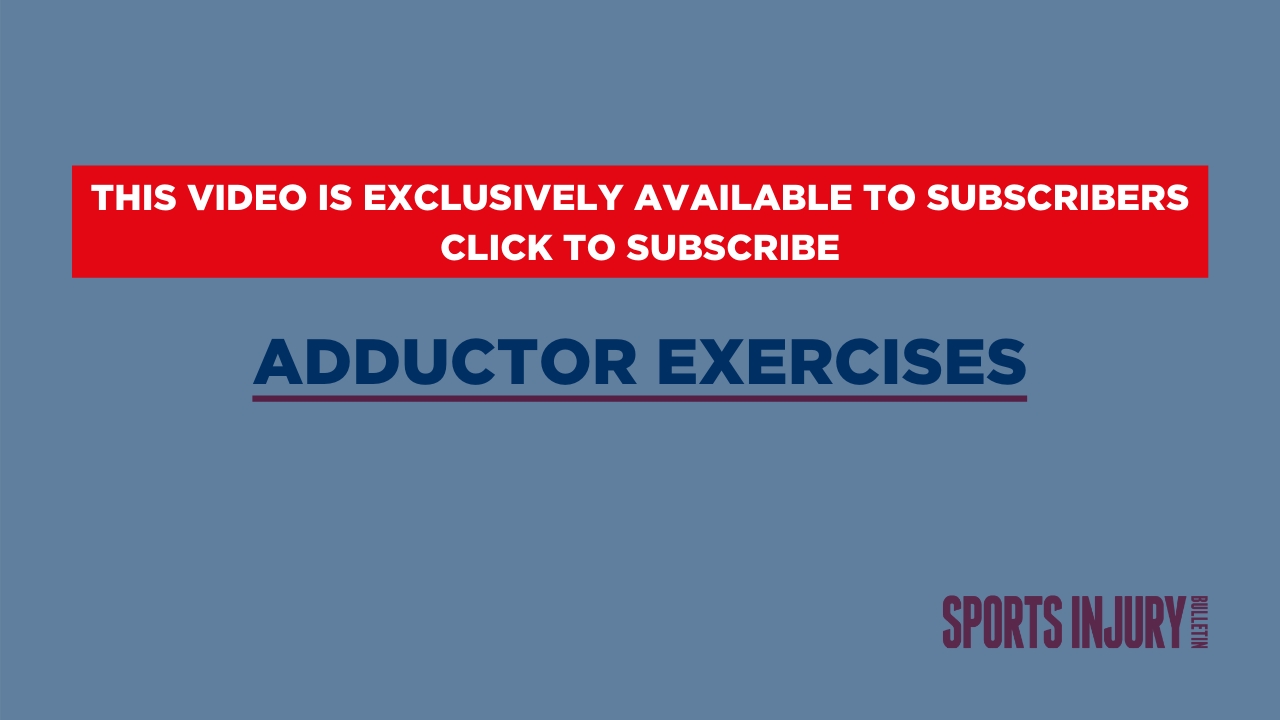
[embed]
Non-adductor exercises
Also, incorporate exercises for the entire lower leg and pelvis to provide comprehensive support to the injury(4). Focus primarily on the posterior kinetic chain - ie the gluteal, hamstring, and calf muscles. Weakness in these muscle groups may contribute to both the closed and open-chain injury mechanism for adductors; providing additional strengthening to these muscles will help offload and protect the adductors.
In this phase, add exercises to foster intersegmental control, and compound movements that mimic the multi-directional and high-speed movements demands of sport(6). These primarily focus on the pelvic musculature. Examples includetrunk-on-pelvis segment exercises like squats and deadlifts, and pelvis-on-femur exercises, such as lunges. This approach targets multi-segmental coordination and develops strength specific to the sport’s movement patterns, providing a stronger foundation upon which build.
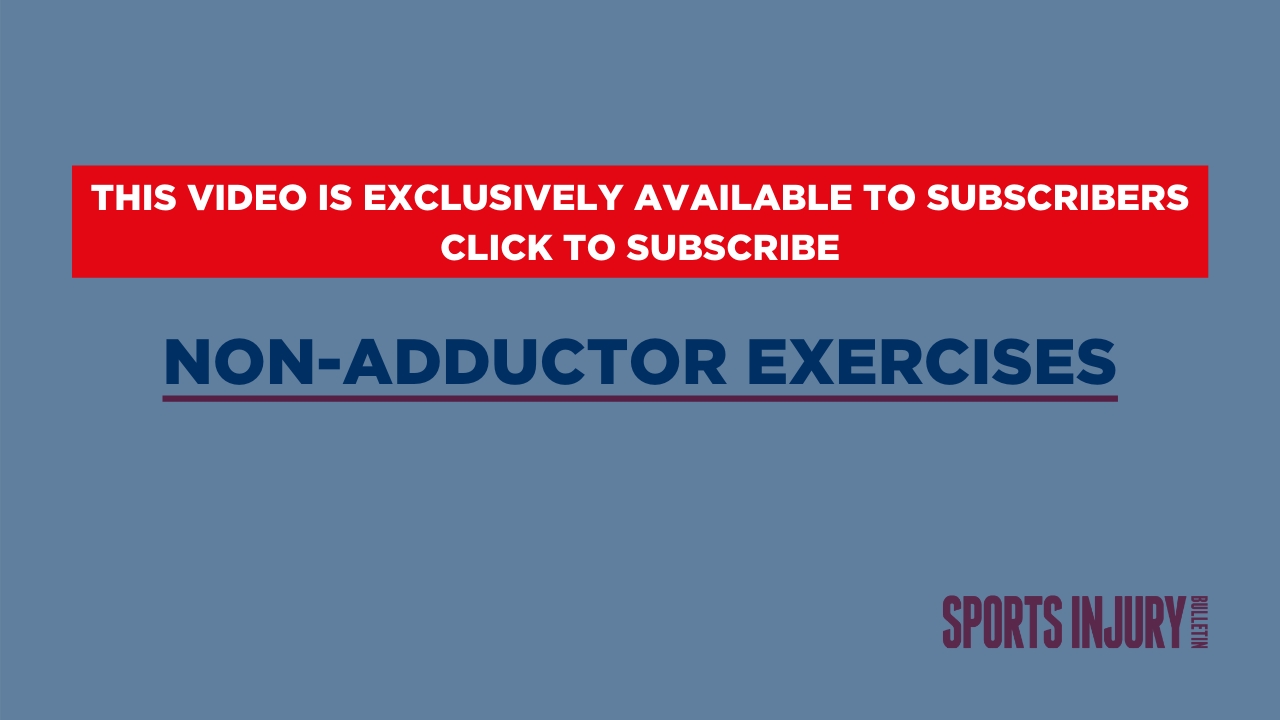
[embed]
Running & sports functionality exercises
Alongside the adductor and non-adductor exercise programs, add a running and sports-function regimen to practice these movement patterns, minimizing time out from this exposure. This protocol consists of four strict progressive phases. Athletes must meet progression criteria before moving to the next stage (see table 2).
| Phase | Exercises | Progression criteria |
|---|---|---|
| 1): Running movements | *Small running in place moving to a slow jog | Completed pain-free at 30% intensity |
| 2): Slow running and side-steps | *Linear running with a gradual increase in speed and time*Narrow side-steps increasing step width and speed*Forward and backward running*Zig-zag shuffles | Run for 15 minutes and complete each drill pain-free with up to 60% intensity |
| 3): Progressive running and direction changes | *30m linear running intervals with increasing speed*Side steps and ladder drills*Accelerations and decelerations*Zig-zag shuffles and turns, with and without a ball | 10 x straight 30m sprints pain-free at 80% intensity |
| 4): High speed running and direction changes | *30m linear running progressed to maximal sprints*Side-steps progressing to maximal speed and step width*Acceleration and deceleration up to maximal speed*Zig-zag shuffles and turning progressing to maximal speed, with or without a ball*Change of directions cutting in at different angles | 10 x straight 30m sprints pain-free at 100% intensityRefer to the return-to-play continuum criteria above for further tests before progressing to sports-specific training |
Rehabilitation outcome measures
Test athletes before starting their rehabilitation to gain a benchmark for their symptoms. Frequent reassessment provides criteria upon which to progress to the next stage of rehabilitation. In addition to the tests described in the RTS continuum, utilize pain-provocation tests, range of movement (ROM), and strength for determining the level of rehabilitation so far(4,6):- Pain tests: Adductor squeeze tests performed at 0°, 45°, and 90°, and the crossover test;
- ROM tests: Bilateral bent knee fall out, passive hip abduction, medial rotation at 90° flexion;
- Strength tests: Side-lying adduction and abduction and outer range eccentric adduction.
Summary
Acute adductor injuries are highly prevalent in sport due to the required rapid change of direction, kicking, and jumpingmovements. A return to sport continuum and frequent re-assessment is vital for ensuring a safe RTS. Criteria-based rehabilitation consists of three phases: return to participation, return to play, and return to performance. A rehab plan should include specific adductor exercises, non-adductor exercises, and progressive running and sports function drills. The use of key outcome measures helps plan the individual’s return from injury, minimize time away from sport, and reduce re-injury risk.References
Newsletter Sign Up
Subscriber Testimonials
Dr. Alexandra Fandetti-Robin, Back & Body Chiropractic
Elspeth Cowell MSCh DpodM SRCh HCPC reg
William Hunter, Nuffield Health
Newsletter Sign Up
Coaches Testimonials
Dr. Alexandra Fandetti-Robin, Back & Body Chiropractic
Elspeth Cowell MSCh DpodM SRCh HCPC reg
William Hunter, Nuffield Health
Be at the leading edge of sports injury management
Our international team of qualified experts (see above) spend hours poring over scores of technical journals and medical papers that even the most interested professionals don't have time to read.
For 17 years, we've helped hard-working physiotherapists and sports professionals like you, overwhelmed by the vast amount of new research, bring science to their treatment. Sports Injury Bulletin is the ideal resource for practitioners too busy to cull through all the monthly journals to find meaningful and applicable studies.
*includes 3 coaching manuals
Get Inspired
All the latest techniques and approaches
Sports Injury Bulletin brings together a worldwide panel of experts – including physiotherapists, doctors, researchers and sports scientists. Together we deliver everything you need to help your clients avoid – or recover as quickly as possible from – injuries.
We strip away the scientific jargon and deliver you easy-to-follow training exercises, nutrition tips, psychological strategies and recovery programmes and exercises in plain English.







